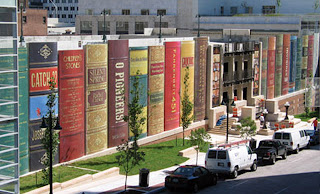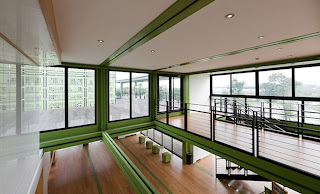The Library of Kansas City, which was founded in 1873, presents an
architectural structure that reflects its function - is unique
building of this kind in the world - "The Community Bookshelf"
is a striking feature of city's downtown. It runs along the
south wall of the Central Library's parking garage on 10th Street
between Wyandotte Street and Baltimore Avenue. The book spines, which
measure approximately 25 feet by 9 feet, are made of aluminum with
applied large format graphics . The shelf showcases 22 titles
reflecting a wide variety of reading interests as suggested by Kansas
City readers and then selected by The Kansas City Public Library
Board of Trustees.
Among
the titles selected are "Cien Anos de Soledad" (100 Years of Solitude)
by Gabriel Garcia Marquez, "The Republic" by Plato, "A Tale of Two
Cities" by Charles Dickens etc.. and Children's Stories like "Winnie the
Pooh" by A. A. Milne or "The Wonderful Wizard of Oz" by L. Frank Baum.
The
project was realized by Dimensional Innovations. It has won
multiple awards; including an SEGD Award and an IDEA award.
The
mission of the Kansas City Public Library is to provide resources,
tools and adequate space in order to create a dynamic urban
community-oriented culture, learning and the expansion of knowledge.
It is considered by its users as an invaluable resource.
More
info
photo
credits: Dimensional Innovation

















































